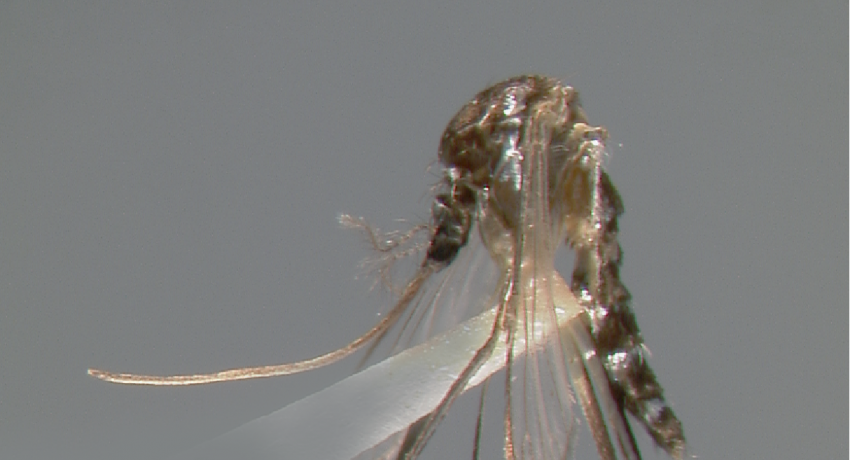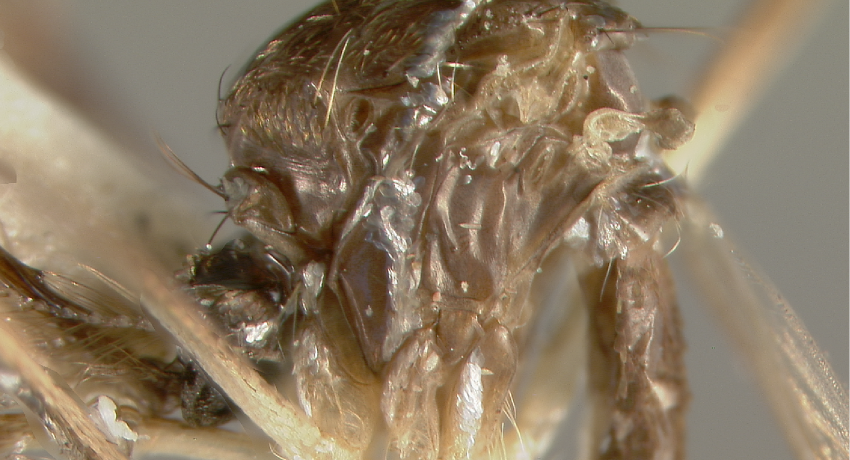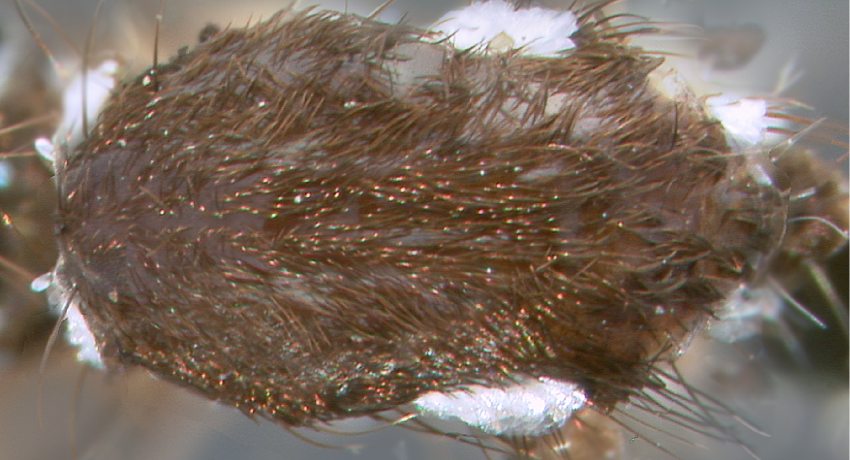ORIENTAL REGION
Generic abbreviation: Ze.
Type species: Zeugnomyia gracilis Leicester
Etymology: “it links on the Uranotaenias [sic] to Colonemyia [sic] and Skeiromyia [sic] and through them to the Wyeomyia [sic]; hence its name.' zygos, Gr. yoke, zeugnymi, to connect, join; myia, Gr. fly” (Harbach 2018c)
Adult Zeugnomyia are characterized by broad vertical stripes of brilliant silver scales along the thorax, and distinctly flat patches of silver scales adorning the head, scutum and abdomen. The genus Zeugnomyia comprises only four described species: Ze. aguilari Baisas & Feliciano, Ze. fajardoi Baisas & Feliciano, Ze. gracilis Leicester and Ze. lawtoni Baisas. All four species occur in the Philippines, with Ze. gracilis also reported from Singapore, Malaysia and Thailand. Described on the basis of male genitalia differences, the Philippine endemics—Ze. aguilari, Ze. fajardoi, and Ze. lawtoni—are inseparable as adult females, or as larvae. Zeugnomyia gracilis females sport unique dark scales on all scutellar lobes, and the male gonostylus lacks a prominent spine evident in all three other species.
DIAGNOSTIC CHARACTERS (Click photos to view; mouse over and click large photo to zoom in.)
ADULT (illustrated): Head: Patches of flat silver scales on head. Thorax: Pleuron with a vertical stripe of silver scales; lower mesepimeral setae present; prespiracular and postspiracular setae absent; dorsocentral setae absent. Wing: Alula bare; upper calypter fringed with setae; vein 1A terminates only slightly beyond level of mediocubital crossvein; cell R2 distinctly shorter than vein R2+3. Abdomen: Patches of flat silver scales.
LARVA (not illustrated): Head: Seta 7-C slender, 1–2 branched; hypostomal suture reaches posterior tentorial pit. Terminal segments: Saddle incomplete, large spines on posterior margin; pecten present; comb with single row of comb scales.
TAXONOMIC KEYS
Delfinado 1966a
Rattanarithikul et al. 2005b
Rattanarithikul et al. 2010
![]()
WRBU – Genera – Global – Larva
![]()
WRBU – Genera – IndoMalaya – Adult
![]()
WRBU – Genera – IndoMalaya – Larva
![]()
WRBU – Genera – Oriental – Adult
![]()
WRBU – Genera – Oriental – Larva
Exemplar DNA sequences
Zeugnomyia gracilis COI: KF564776, KF564778
BIONOMICS
Immatures
Ovipositing females primarily seek rainwater collections in natural forest containers to their eggs. Immatures have been recovered from Anahaw palm leaf axils, tree holes, cut bamboo, and fallen abaca and coconut spathes; and were once reported occupying a discarded tin can. The larvae of Ze. gracilis are predacious.
Adults
Adults are found in heavily shaded forest environments. In Malaysia, female Ze. gracilis bite humans, but the feeding habits of other species are not elucidated.
*Associated pathogens: This list reports bacteria, viruses, and parasites recovered from, or experimentally passed through this species, and does not imply field vector status.
IMPORTANT REFERENCES (full citations below)
Baisas & Feliciano 1953: 161 (tax.; Philippines)
Delfinado 1966a: 60 (tax. keys; Philippines)
Benjaphong & Rattanarithikul 1991 (distr.; Thailand)
Reinert 2000d (F gen.*)
Reinert et al. 2004 (phyl. class.)
Rattanarithikul et al. 2005b (generic keys, bion., distr.; Thailand)
Reinert et al. 2009 (phyl. class.)
Rattanarithikul et al. 2010 (F*, L*; keys, bion.; Thailand)
Wilkerson et al. 2015 (phyl. class.)
VALID SUBGENERA
None
CURRENT GENERIC SYNONYMS
None
CITED REFERENCES
Baisas, F. E., & Feliciano, P. (1953). Notes on Philippine mosquitoes. XIII. Four new species of Zeugnomyia and Topomyia. Fieldiana Zoology, Chicago, 33(3), 161–179.
Benjaphong, N., & Rattanarithikul, R. (1991). Zeugnomyia gracilis Leicester (Diptera: Culicidae), a new genus and species occurrence recorded from Thailand. Mosquito Systematics, 23(1), 53.
Delfinado, M.D. (1966a). The culicine mosquitoes of the Philippines, tribe Culicini (Diptera, Culicidae). Memoirs of the American Entomological Institute, 7, 1–252.
Rattanarithikul, R., Harbach, R.E., Harrison, B.A., Panthusiri, P., Coleman, R.E., & Richardson, J.H. (2010). Illustrated keys to the mosquitoes of Thailand VI. Tribe Aedini. Southeast Asian Journal of Tropical Medicine and Public Health, 41(1), 1–225.
Rattanarithikul, R., Harrison, B.A., Panthusiri, P., & Coleman, R.E. (2005). Illustrated keys to the mosquitoes of Thailand. I. Background; geographic distribution; lists of genera, subgenera, and species; and a key to the genera. Southeast Asian Journal of Tropical Medicine and Public Health, 36(1), 1–80.
Rattanarithikul, R., Harrison, B.A., Panthusiri, P., & Coleman, R.E. (2005b). Illustrated keys to the mosquitoes of Thailand. I. Background; geographic distribution; lists of genera, subgenera, and species; and a key to the genera. Southeast Asian Journal of Tropical Medicine and Public Health, 36(1), 1–80.
Reinert, J.F. (2000d). Comparative anatomy of the female genitalia of genera and subgenera in tribe Aedini (Diptera: Culicidae). Part IV. Genus Zeugnomyia Leicester. Contributions of the American Entomological Institute, 32(2), 45–52.
Reinert, J.F., Harbach, R.E., & Kitching, I.J. (2004). Phylogeny and classification of Aedini (Diptera: Culicidae), based on morphological characters of all life stages. Zoological Journal of the Linnean Society, 142, 289–368.
Reinert, J.F., Harbach, R.E., & Kitching, I.J. (2009). Phylogeny and classification of tribe Aedini (Diptera: Culicidae). Zoological Journal of the Linnean Society, 157(4), 700–794.
Wilkerson, R.C., Linton, Y.-M., Fonseca, D., Schultz, T., Price, D., & Strickman, D. (2015). Making mosquito taxonomy useful: A stable classification of tribe Aedini that balances utility with current knowledge of evolutionary relationships. PLoS ONE, 10(7), e0133602.
CITE THIS PAGE
Walter Reed Biosystematics Unit (Year). Zeugnomyia genus page. Walter Reed Biosystematics Unit Website, http://wrbu.si.edu/vectorspecies/genera/zeugnomyia, accessed on [date (e.g. 03 February 2020) when you last viewed the site].






